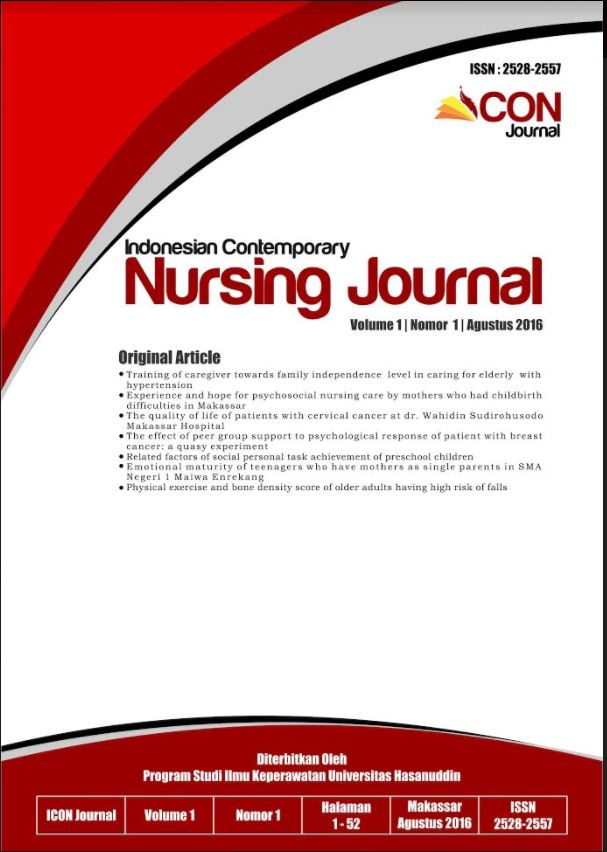Physical Exercise and Bone Density Score of Older Adults Having High Risk of Falls
DOI:
https://doi.org/10.20956/icon.v1i1.3368Abstract
Introduction: Decreased Bone Mineral Density (BMD) is considered as a determining factor of injury from falls. Previous study revealed that physical exercise contributes to the changes of fall risk of older adults with leg muscle strength, balance, and BMD as its intervening variable. This study aimed to determine the effect of physical exercise on BMD value among elderly with high risk of fall in Makassar. Method: We used two-group pretest-posttest design. Ten women aged > 60 with high risk of fall were involved using purposive sampling based on inclusion and exclusion criteria. The researchers used exercise guidelines made by Indonesian Ministry of Youth and Sport. BMD was measured on the sole of the feet using Bone Densitometry and interpreted as z-score. Data were processed using SPSS and tested by Paired Sample T-Test and Independent T-Test. Result: Almost half of the elderly had low BMD value that leads to osteopenia. There was no effect of physical exercise to the BMD changes among elderly (p = 0.675 for experiment group) and significant difference for both groups wasp = 0.86. However, mean difference showed that experiment group had higher changes of BMD value compared to control group. Conclusion: Physical exercise has no overall treatment effect on bone mineral density in older women with high risk of fall. It is recommended that a longer period of time of physical exercise. Measured BMD using DXA on hip and lumbar spine is also needed for further studies
References
Alberti, K. G. M. M., Zimmet, P., & Shaw, J. (2007). International diabetes federation: a consensus on type 2 diabetes prevention. Diabetic Medicine, 24(5), 451–463. http://doi.org/10.1111/j.1464-5491.2007.02157.x
Hinton, P. S., Rector, R. S., Linden, M. A., Warner, S. O., Dellsperger, K. C., Chockalingam, A., … Thomas, T. R. (2012). Weight-loss-associated changes in bone mineral density and bone turnover after partial weight regain with or without aerobic exercise in obese women. European Journal of Clinical Nutrition, 66(5),606–612. http://doi.org/10.1038/ejcn.2011.212.Weight-loss-associated
Kemmler, W. (2010). Exercise effects on bone mineral density, falls, coronary risk factors, and health care costs in older women: the randomized controlled senior fitness and prevention. Retrieved from http://archinte.jamanetwork.com/article.aspx?articleid=774236
Malasari, S., Jafar, N., & Rahayu, A. I. (2015). Physical exercise towards the changing score of risk falls on elderly. Indonesian Nursing Journal of Education and Clinic, 2(1), 108–112. Retrieved from http://gatotkacasoft.com/index.php/INJEC/article/view/19/19
Marques, E. A., Mota, J., & Carvalho, J. (2011). Exercise effects on bone mineral density in older adults: a meta-analysis of randomized controlled trials. AGE, 34(6), 1493–1515. http://doi.org/10.1007/s11357-011-9311-8
Marques, E. A., Wanderley, F., Machado, L., Sousa, F., Viana, J. L., Moreira-gonçalves, D., Carvalho, J. (2011). Effects of resistance and aerobic exercise on physical function , bone mineral density, OPG and RANKL in older women. EXG, 46(7), 524–532. http://doi.org/10.1016/j.exger.2011.02.005
Pernambuco, C. S., Borba-Pinheiro, C. J., Vale, R. G. de S., Di Masi, F., Monteiro, P. K. P., & Dantas, E. H. M. (2013). Functional autonomy, bone mineral density (BMD) and serum osteocalcin levels in older female participants of an aquatic exercise program (AAG). Archives of Gerontology and Geriatrics, 56(3), 466–71. http://doi.org/10.1016/j.archger.2012.12.012
Rubenstein, L. Z. (2006). Falls in older people: epidemiology, risk factors and strategies for prevention. Age and Ageing, 35 Suppl 2(suppl_2), ii37–ii41. http://doi.org/10.1093/ageing/afl084
Sherrington, C., Whitney, J. C., Lord, S. R., Herbert, R. D., Cumming, R. G., & Close, J. C. T. (2008). Effective exercise for the prevention of falls: a systematic review and meta-analysis. Journal of the American Geriatrics Society, 56(12), 2234–43. http://doi.org/10.1111/j.1532-5415.2008.02014.x
Shumway-Cook, A., Brauer, S., & Woollacott, M. (2000). Predicting the probability for falls in community-dwelling older adults using the timed up & go test. Physical Therapy, 80(9), 896–903. Retrieved from http://ptjournal.apta.org/content/80/9/896.abstract
Sutter Health. (2015). Diagnosing Osteoporosis. Mills Peninsula Health Services. Retrieved from http://mills-peninsula.org/arthritis/diagnosing_osteo.html
Uusi-rasi, K., Patil, R., Karinkanta, S., Kannus, P., Tokola, K., Lamberg-allardt, C., & Sievänen, H. (2016). Exercise and vitamin d in fall prevention among older women a randomized clinical trial. JAMA Intern Med., 175(5), 703–711. http://doi.org/10.1001/jamainternmed.2015.0225
Zhu, K., Devine, A., Lewis, J. R., Dhaliwal, S. S., & Prince, R. L. (2011). “Timed up and go” test and bone mineral density measurement for fracture prediction. Archives of Internal Medicine, 171(18), 1655–61. http://doi.org/10.1001/archinternmed.2011.434
Downloads
Published
How to Cite
Issue
Section
License
Authors who publish with this journal agree to the following terms:Authors retain copyright and grant the journal right of first publication with the work simultaneously licensed under a Creative Commons Attribution License that allows others to share the work with an acknowledgement of the work's authorship and initial publication in this journal.
Authors are able to enter into separate, additional contractual arrangements for the non-exclusive distribution of the journal's published version of the work (e.g., post it to an institutional repository or publish it in a book), with an acknowledgement of its initial publication in this journal.
Authors are permitted and encouraged to post their work online (e.g., in institutional repositories or on their website) prior to and during the submission process, as it can lead to productive exchanges, as well as earlier and greater citation of published work (See The Effect of Open Access).



